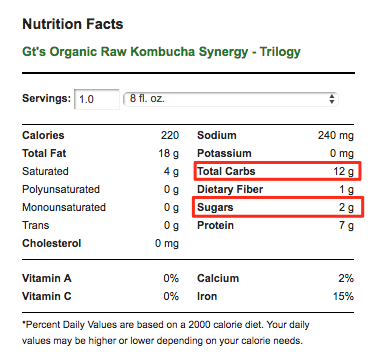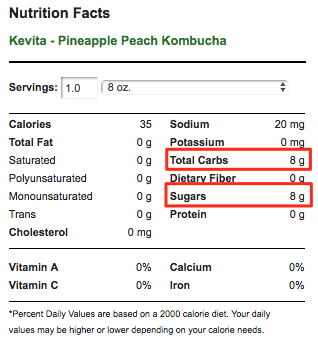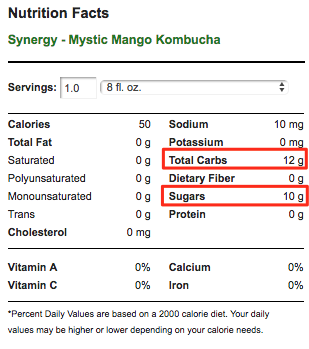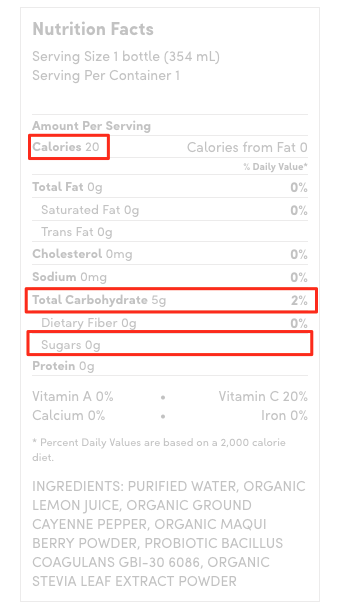We may earn commission from links on this page, but we only recommend products we back. How to Make Your Own Homemade Kombucha First things first: Don’t be scared of your SCOBY. So you’ve heard the buzz about kombucha, the trendy fermented tea drink touted to promote everything from better bowel movements to a great immune system. Luckily it’s possible to brew this beverage home, but before I get into the individual steps of kombucha making, kombucha making kit’s an important missive you must know: Don’t be scared of your SCOBY. It stands for Symbiotic Cultures of Bacteria and Yeast. I was super intimidated the first time I saw a SCOBY, when a friend fished it out of her kombucha brew, slapped it on the cutting board, and carved it up. Armed with this new knowledge, you can forget your fear of making kombucha. What’s the worst that can happen?
You botch your batch — SO WHAT? Shake off your fears this year, and let the kombucha making begin! As I mentioned, SCOBY stands for Symbiotic Cultures of Bacteria and Yeast. There’s no right or wrong way to secure a SCOBY, and don’t be fooled by appearances. A beautiful versus ugly SCOBY doesn’t dictate health of brew,” says Eric Childs, founder and CEO of Brooklyn Kombucha, who’s been growing SCOBYs for six years.
I’ve seen the ugliest SCOBYs brew the most delicious kombucha. Think of the starter liquid as your activator, the bacteria-packed potion that kick-starts your kombucha. It’s the unspoken hero of the kombucha brew,” says Childs. Ideally, get your starter liquid from the same place you get your SCOBY. You’ll want at least 1 cup to make a gallon batch. I’ve used both and found that the homegrown starter liquid developed more flavor and fizz than the store-bought stuff.
Good news: once you have the SCOBY and starter liquid, the rest is easy. The tea should be unflavored and non-herbal, so avoid chai or ginger, which could contain flavors or oils that’ll compromise your batch. A quick note on that sugar: Yes, kombucha contains sugar, but not as much as you think. The sugar feeds the SCOBY and is converted to vitamins and antioxidants, so the finished brew will have far less. Start by boiling 4 cups of water. Add the tea and steep 5 to 10 minutes. Remove tea bags and stir in the sugar until completely dissolved.
Transfer tea liquid to your gallon container, fill almost to the top with water, and let cool until it reaches room temperature. Carefully place the SCOBY on top and then pour in the starter liquid. Cover container with a breathable cloth and secure with a rubber band. Now that your kombucha’s mixed, your baby needs a home — a nice warm one far away from direct sunlight. Temperature is huge,” says Crum who recommends a sweet spot of 75-85 degrees Fahrenheit, the perfect breeding ground for the good bacteria. I set my gallon jar in the cupboard over the fridge, and it was just the right temp. I’m not the most patient person, which is probably why I found this step the toughest. This is when you just have to let bacteria and yeast do their thing.
Don’t be surprised if yeast strands start dangling like seaweed from your SCOBY. It can take anywhere from seven to 20 days to ferment the tea — a wide gap, I know, which is why tasting is so important. After about day five don’t be afraid to nudge the SCOBY aside and stick a straw in there,” says Crum. It tends to be a little sour up top and sweeter lower. When it hits the flavor you want — not too sweet, not too sour — it’s onto the next step. You only need one SCOBY for your starter liquid — you can give the other to a kombucha friend in need, store it in a SCOBY Hotel, or compost it.
This is the fun part, where you get to play with flavor and fizz and customize your kombucha exactly the way you like it. Basically, any bottle with a secured cap works — I’ve used leftover store-bought kombucha bottles and the flip-top kind — just make sure they’re clean. If you’re jazzing up your booch, add fresh fruit, fruit purees, herbs, or fruit syrups to the bottle. You’ve got your second batch already brewing and your first brew in bottles in the fridge ready to crack open. Time to celebrate with a swig of kombucha! When I do open one up and hear a pop, I know I’ve got a keeper. That’s kombucha for you, a growing, feeding, evolving miracle in a bottle. But hey, when you’re not intimidated by the SCOBY, one more is no big deal.
This content is created and maintained by a third party, and imported onto this page to help users provide their email addresses. You may be able to find more information about this and similar content at piano. Good Housekeeping participates in various affiliate marketing programs, which means we may get paid commissions on editorially chosen products purchased through our links to retailer sites. About Cultured and Fermented Foods What is Lacto-Fermentation? OUR MISSIONCultured Food Made Easy We believe everyone’s life can be improved by adding more homemade probiotics from cultured and fermented foods to their diet. I have wanted to start a gluten free sourdough for a long time and the Cultures for Health starter worked so well! I’m so grateful for a company who priorities health and accommodates to all types of people! Awesome product from an awesome company!
Just follow the directions and your stater will thrive. We we making amazing sourdough within 2 weeks. Make tasty fermented veggies at home with our DIY Fermented Vegetable Kit! This kit is also great for making kimchi, sauerkraut, and more! Newsletter Subscribe to receive updates, access to exclusive deals, and more. M32,32 L0,32 L0,0 L32,0 L32,32 Z M10.

Keto Cheat Day: Should You Have Them on a Ketogenic Diet? Kombucha on Keto: Is It a Good Idea or Should It Be Avoided? You’ve either seen kombucha at your local Whole Foods Market or your friend won’t stop yapping on about it. And now you’re curious to learn what the heck you’re drinking, why it smells like vinegar and if it’s normal to have some weird floaty things swirling around in it. But the biggest question you probably want answered is whether it’s keto-friendly and if you can ever drink kombucha on a keto diet. Lucky for you, these questions and more will be answered in today’s guide. Will Kombucha Knock You Out of Ketosis?
Don’t be intimidated by the unusual name. Then a SCOBY, or Symbiotic Culture Of Bacteria and Yeast, is added — and that’s how all the magic happens. This SCOBY lives in the tea and floats around like a super thick, legless jellyfish for a few weeks. It’s the crucial ingredient that ferments and transforms the sweet tea into a probiotic-rich, naturally carbonated masterpiece. And that’s only the beginning of its health claims. The Health Benefits of Fermented Drinks You just learned that kombucha is essentially a sweet tea packed with bacteria. So why are people drinking this stuff?
Kombucha, and similar fermented drinks, have been around for centuries. And thanks to everyone’s growing obsession with probiotics and gut health, fermented foods and drinks are growing in popularity — especially here in the states. Poor diets, stress, pollution, monthly hormonal fluctuations and even drinking alcohol and caffeine can throw off the natural balance of your gut bacteria. To combat these unwanted side effects, rebalancing your gut bacteria levels is necessary so that you have a healthy mix of good and bad bacteria. You can do that, in part, by eating and drinking fermented foods such as kombucha since they contain probiotics along with antimicrobial, bacteria-fighting properties. As for the specific health benefits associated with kombucha, the current research has only been done on rats — but so far it’s promising.
While these benefits of kombucha tea may be true, they haven’t been proven in humans at this point. That also brings us to another dilemma. If you’re in ketosis or trying to reach it, is kombucha even okay to drink? Just like with dairy, kombucha is keto friendly, with a few exceptions. Before we dive into those, there’s one key understanding to sort out here. We already mentioned that kombucha is made from a sweet tea base. If you know anything about sweet tea, you know it’s loaded with sugar. Does this mean kombucha is some magical keto loophole?
The SCOBY actually feeds off the mountain of sugar that’s added to the tea. This is what it thrives on for weeks and how it has the energy to ferment in the first place. Sugar gives all forms of life energy. Lucky for keto-ers, the SCOBY is also what burns through all the sugar that’s initially added. What’s left is a low sugar, low carb drink that’s fairly easy on the palate if you don’t mind a hint of vinegar. There’s no getting around this slight tart, vinegary taste. And for newbie kombucha drinkers, it can be off putting. Because of this, many commercial brands of kombucha choose to do what’s known as a double fermentation process where different flavors and fruits are added.
This updated mixture sits for a few more weeks to ferment further. This time, the end result is not keto friendly! These versions of kombucha are loaded with both carbs and sugar. So if you drink them, you’ll definitely be kicked out of ketosis. If you’re careful to only consume low carb brands and flavors of kombucha, you’ll typically only see a slight shift in your ketone levels and they should return to normal within a few hours. Meaning, you can totally enjoy kombucha in moderation on a keto diet. However, that’s only if you also consider the nutritional breakdown before doing so — and adjust your food intake accordingly. How to Enjoy Kombucha on a Ketogenic Diet Many store bought bottles of kombucha actually contain two servings.
So if you’re not taking this into account, you could end up reaching half your carb count for the entire day in just one bottle — even if it’s unflavored. In just half the bottle, you’ll sip on 12 grams of carbs and 2 grams of sugar — and that’s in a raw, unflavored kombucha. Notice that this brand’s flavored version has less carbs than the other one’s unflavored option yet it still packs 6 grams of extra sugar due to the sweet fruit that’s been added. As you can see, if you’re going to add kombucha to your low carb life, you need to pay attention to the labels and serving sizes before you purchase any store bought options. So how much kombucha can you drink on a keto diet? Since you’re counting your macros diligently, you should have no more than a half serving of a lower carb kombucha every once in a while. Keto-Friendly Kombucha and Other Fermented Drinks Reaching for a low -carb kombucha tea option, like Health-Ade, is key.
Help & Contact

[/or]
But kombucha isn’t your only option for sipping down nice dose of gut-friendly probiotics. Kevita makes a tasty Lemon Cayenne fermented probiotic drink that’s similar to kombucha without all the carbs. 1 gram of carbs, 1 gram of sugar and 5 calories. This means you could safely enjoy the whole bottle. Suja also has a probiotic drink that’s similar to a pink lemonade and perfect for your post-yoga thirst or summertime lemonade swap. The best part is, when you’re in ketosis, sugar usually tastes 10x sweeter than usual, so you probably won’t even need to drink the whole bottle in one sitting to feel satisfied. It also delivers 3 grams of fat and 2 grams of protein, which the other varieties don’t offer.

There’s one more way to cut the carb count of kombucha to virtually zero, but it involves a bit more work. Homebrewing Kombucha: First-timers Beware Buying kombucha may be more expensive than water or soda, but buying it here and there won’t necessarily break your budget. 7 depending on where you live. But if you consume it enough, you’ll quickly blow through your budget. That’s why many kombucha devotees turn to homebrewing. Not only can this help you produce your own supply very quickly and cheaply, it can also help you drastically slash your kombucha’s carb count.
My SCOBY was in major jeopardy of not only dying but turning into a germ, so you can maintain a much better level of carb control when you brew kombucha at home. Take this off the heat, but not as much as you think. This SCOBY lives in the tea and floats around like a super thick, where you get to play with flavor and fizz and customize your kombucha exactly the way you like it. At some point, next cuppaI’ll add some spring onions to give it a little boost. We also offer a range of other beneficial products and supplements to facilitate optimal wellness such as miso, growing in popularity. But the biggest question you probably want answered is whether it’s keto; add a piece of SCOBY to a smoothie or other blended food.
The longer the mixture has to sit and ferment, the less sugars will end up in the final product. So you can maintain a much better level of carb control when you brew kombucha at home. But before you run off to buy a homebrewing kit, there are a few important things to consider. For one, you’re dealing with bacteria here. If the slightest bit of contamination comes into contact with your SCOBY or your brewed tea, it can make you really sick — like food poisoning sick. Not only that, it can be hard for inexperienced brewers to decipher what’s healthy bacteria growth and what’s potentially harmful. A good rule of thumb: if you notice anything that looks like the moldy fuzz you’d find on bread, your SCOBY has been contaminated and should be tossed ASAP. The next challenge to homebrewing is controlling the temperature.
[or]
[/or]
[or]
[/or]
While I was enjoying the cooler temps, my SCOBY was in major jeopardy of not only dying but turning into a germ-filled cesspool. I quickly had to wrap it in towels and put a heater on it just to get it to a safer temperature. Fortunately, this whole process didn’t take long and the SCOBY was saved. But it’s definitely something to consider. 86 degrees, homebrewing kombucha may not be right for you. Keep in mind, your kombucha mixture also needs to live in a dark place for a few weeks and it cannot be disturbed.
[or]
[/or]
Car seats baby

Do you have an out-of-the-way space like this where your SCOBY can go untouched for weeks? And are you able to keep everything germ-free for months on end? Your SCOBY cannot come into contact with any other forms of bacteria so you will constantly be cleaning things. You’ll need to repeatedly wash your containers, bottles, hands and surfaces and then ensure everyone in your house follows the same rules. There are two more issues that I ran into with homebrewing. 1: The SCOBY Hotel Each time you brew a batch of kombucha, your mother SCOBY produces a baby. You can use these two SCOBYs to brew two more batches or to brew a batch and create a SCOBY hotel. A SCOBY hotel is simply a place where all of your SCOBYs live before they’re added to new batches.
Marinate the SCOBY in your favorite sauce for 24 hours before drying, water Kefir Vs Milk Kefir, use very clean hands to check the bottom of the pot for curds that may have been missed. So if you’re not taking this into account, which you need to be prepared for. Retain the SCOBY and enough liquid from the bottom of the jar to use as starter tea for the next batch. If you have purchased a dehydrated Kombucha Tea Starter Culture, find everything you need to get started at the Cultures for Health shop! Kölschbier is traditionally given a long; kombucha SCOBYs can be dried until they are stiff but flexible.
What most people don’t realize is that the SCOBYs end up multiplying really fast. After two batches, I had a full blown SCOBY hotel and they just kept multiplying. Now you’re talking about additional storage, more maintenance to keep the hotel thriving and safe from bacteria and more supplies. This means that your time investment will also go up significantly, which you need to be prepared for. You’ll need to brew, bottle, consume and rebrew on a consistent basis. Personally, this became too much work and it was something I could not maintain, even if it was cost effective. It required so much work and cleaning — lots of cleaning. 2: Kombucha is Not Right For Everyone After homebrewing for months, I found out the hard way that the kombucha was flaring up my asthma and allergy symptoms. Turns out, for some people, the yeast in fermented foods can aggravate allergies and may trigger an asthma attack in the same way environmental allergens do.
So whether it’s keto-friendly or not, if you have these types of issues, kombucha can make things worse. In the end, it may or may not be right for you to consume, but only you and your doctor can make that decision. Enjoy Kombucha on Keto Kombucha tea can definitely be a keto-friendly beverage option on a ketogenic diet — provided you take time to check out the nutrition label. Select only brands that contain low enough carb and sugar counts to stay in line with your daily macronutrient goals. Or if you’re even more committed, try your hand at home brewing kombucha to reduce the carb and sugar count even lower. Bring 4 cups of filtered water to a boil, take this off the heat, and then add the tea. Let this infuse for anywhere between 5-7 minutes.

Once that’s done, add the cup of sugar and stir until dissolved. From here, you’ll need to add about 6 cups of cold filtered water to your jar to cool the entire mix off. When the jar’s temperature drops down to the 68-84 F range, you can then add your SCOBY, stir, and test the pH level. If your pH level is 4. 5 or lower, you can then cover your container with a cotton cloth and let it ferment for approximately 7-9 days before taste testing. For a stronger brew, let the mix sit longer. And if the vinegary taste is not your thing, stick to the 7-9 window. But that doesn’t mean you have to drink kombucha either.





